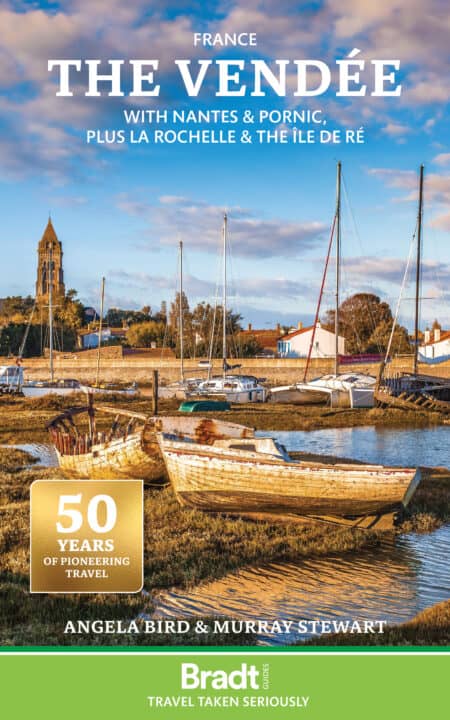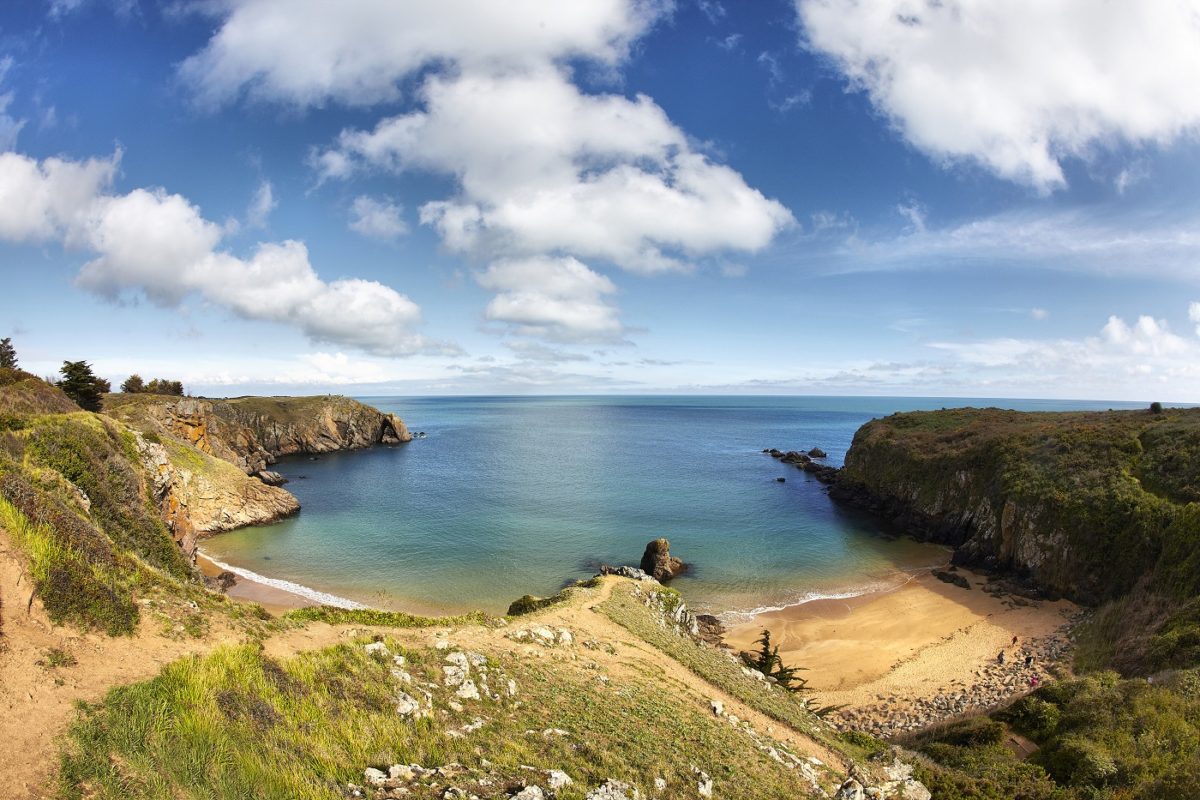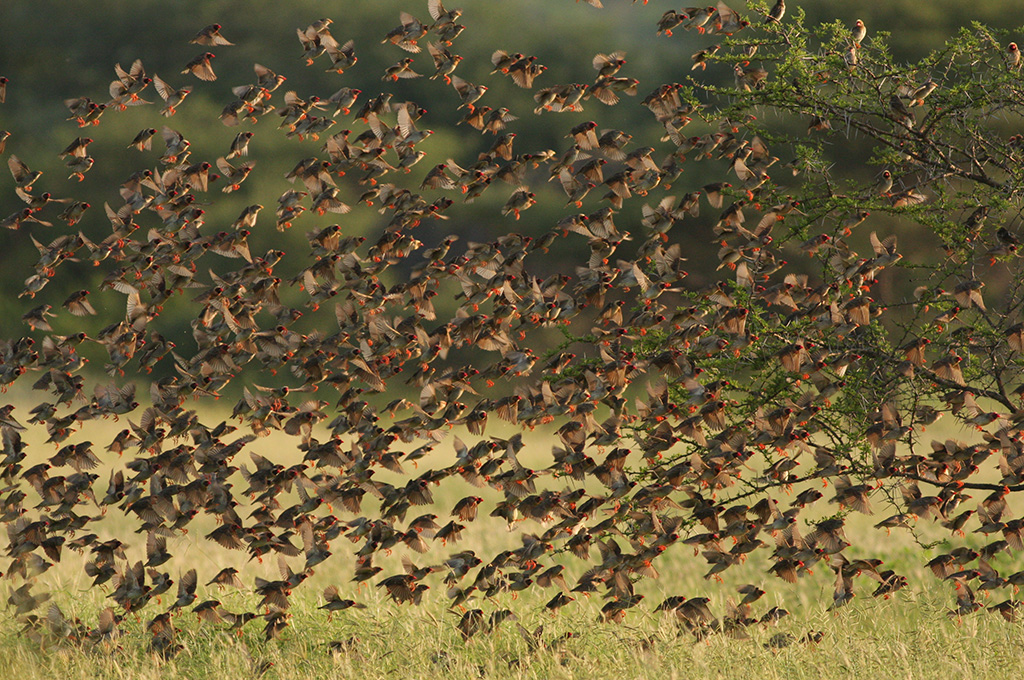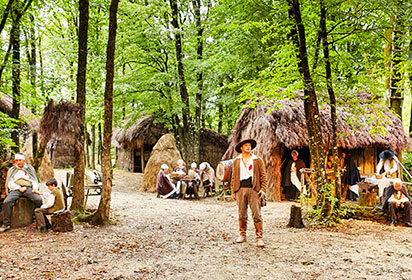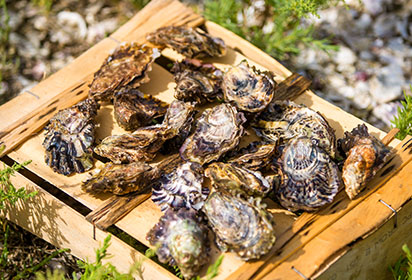Lying between the major cities of Nantes and La Rochelle, the Vendée is tucked cosily into the top of the Bay of Biscay, just south of Brittany. Admittedly, unless you are heading specifically to it, you are unlikely to pass through. But that would be a pity.
Angela Bird and Murray Stewart, authors of The Vendée and surrounding area: the Bradt Guide
France is one of our hot destinations for the year ahead – check out the full list of the best places to travel in 2024 here.
The Vendée has everything you could want on holiday, from brilliant beaches to bloody history, juicy mussels to flavoursome wines, glittering saltpans to fantastic family entertainment. This sea-lapped département of the Pays de la Loire region is rich in wildlife, too. Its marshland habitats are just the place to see otters and coypu, storks and sacred ibis.
Don’t miss taking a trip to the Atlantic islands: Noirmoutier, Yeu and – just beyond the border, in Charente-Maritime – the sun-baked Île de Ré. Near this last island lies the historic town of La Rochelle, with its cobbled streets, myriad restaurants and harbourside watchtowers.
To the north of the Vendée, in neighbouring Loire-Atlantique, a more Breton flavour reigns at pretty Pornic, classy La Baule, or at Monsieur Hulot’s favoured holiday resort of St-Marc-sur-Mer. Work your way along the river Loire from St-Nazaire to the fantastic city of Nantes – and seek out some bizarre art installations on the way. After admiring Nantes’ sophisticated shops and fascinating museums, head for the town’s former shipbuilding district for a ride on a 12-metre-high mechanical elephant.
No visit to the Vendée would be complete without a day (or two) at Puy du Fou. The name embraces a daytime destination classed among the world’s top theme parks for its irresistible blend of entertainment and history; by night, 2,400 locals act out France’s most famous – and dazzling – son-et-lumière spectacle on a vast open-air stage alongside 130 horsemen and some astounding special effects.
Food and drink in The Vendée
You can eat very well in the Vendée, there’s little doubt about that. Traditional local specialities are hearty, peasant food like cabbage, and the white haricot beans known as mogettes – that would be set to simmer slowly in the embers of the kitchen fire while a family toiled in the fields. With such a long coastline and active fishing industry, fish and shellfish are an important part of the culinary repertoire. It’s true that this is not the French département with the most refined, sophisticated food, but the excellence of what you will find here depends on the focus on a number of high-quality raw ingredients and products that make the short journey from sea or land to the plate with not too much human interference. As you might expect, La Rochelle and Nantes offer a greater range of ethnic cuisine than you will find in the Vendée itself.
Health and safety in The Vendée
Health
Obviously, it is best to take out comprehensive travel insurance for your annual holiday. Visitors from the UK should always take their European Health Insurance Card (EHIC). With this, you can claim some reimbursement of medical expenses under the reciprocal arrangement between Britain and France. Keep an eye on the expiry date of your EHIC; again, post-Brexit arrangements may affect UK residents’ entitlements from this scheme in the future.
After consulting and paying the doctor or dentist take the feuille de soins (medical treatment form) that you are given and hand it to the chemist with your ordonnance (prescription) form. The chemist dispenses the drugs (it is most important to keep any sticky labels from the boxes), and add their details to the form. Gather together the form and sticky labels, your EHIC and passport (or a photocopy of its important pages, if you are posting it). Take or send these to the nearest Caisse Primaire d’Assurance Maladie (CPAM), which are located at La Roche-sur-Yon, Challans, Fontenay-le-Comte, Luçon, Les Herbiers and Les Sables-d’Olonne. You should get quite a large percentage of your costs reimbursed.
The offices at La Roche and Les Sables can arrange to hand over the cash, or at least a cheque you can cash locally; otherwise the system operates by sending a cheque to your home address in around six weeks.
Chemists are often consulted about minor ailments and discuss them with doctor-like gravity, binding up sprained ankles and dishing out reasonably strong medicines without the need for getting into the intricacies of the French health system. You do not, however, get reimbursed for this treatment.
For a minor beach injury, seek out the lifeguard post, where personnel should be trained in first-aid. For a serious accident or illness, call 15 from a fixed phone for the SAMU (paramedics), or 18 for the pompiers (fire brigade). The pompiers have ambulances too, and are trained in medical emergency treatment; they are often likely to be quickest on the scene if you are a long way from a town. From a mobile phone, dial 112 to reach any of the emergency services, and the operator will be able to pinpoint your position. Main hospitals are signposted with a red cross logo, either as (in ascending order of importance): CH (centre hospitalier); CHD (centre hospitalier départemental); CHR (centre hospitalier régional); or CHU (centre hospitalier universitaire).
There are Accident & Emergency departments (urgences) at: Challans (CH, Boulevard de l’Est, on the northeast corner of the inner ring road); Les Sables-d’Olonne (CH, on the D160, 4km northeast of Les Sables); La Roche-sur-Yon (CHD, on the Cholet road at Les Oudairies, on the northeast side of town), which has satellite establishments in Luçon and Montaigu. Outside the Vendée, you will find urgencies at Nantes (CHU Hôtel-Dieu, Place Alexis-Ricordeau, in the city centre); St-Nazaire (CH, Boulevard Georges Charpak, west of the centre); Cholet (CH, Rue Marengo, southwest of town); Niort (CH, 40 Avenue de Gaulle, south of the city); and La Rochelle (CH, Boulevard Joffre, east of the centre).
Travel clinics and health information
A full list of current travel clinic websites worldwide is available on ISTM. For other journey preparation information, consult NaTHNac (UK) or CDC (US). Information about various medications may be found on NetDoctor. All advice found online should be used in conjunction with expert advice received prior to or during travel.
Safety
In respect of activities, safety rules and regulations are not always as stringently adhered to as they are in the United Kingdom. You are now usually routinely issued with lifejackets or hard-hats before canoeing, horseriding or karting jaunts, and bike helmets must be worn by the under 12s. Where given the choice of wearing bike helmets or not, French adults seem to choose not to, but tougher laws may follow soon. Safety arrangements at zoos, wildlife parks, lofty viewpoints and some amusement parks can still occasionally seem a bit casual.
As regards personal safety in The Vendée, street-crime rates are mercifully low. Nevertheless, upgrade your vigilance in crowded markets and lock valuables in the boot of your car. Seaside towns have their share of unruly summer visitors, but if you avoid dodgy nightspots and dark back streets you should be unaffected by them. As in major cities anywhere, it pays to be streetwise about money or valuables when visiting larger places such as Nantes or St-Nazaire.
Most people will be aware of the terrorist attacks which have struck France in recent years. Although these initially targeted Paris, the awful Bastille Day strike on Nice in 2016 showed that other towns are not immune, and it is now common to see armed police at airports or patrolling the promenades of seaside resorts. Visitors can play their part by looking after their belongings and staying vigilant. For the latest advice, do check the Foreign and Commonwealth Office website. If you have a
Smartphone, you can also download a recently created App known as SAIP (système d’alerte et d’information des populations) which gives alerts to any major incidents of a natural, terrorist or technological nature. Road safety is an issue for everyone, residents and visitors alike, with road deaths nearly twice the level experienced in the UK.
As regards safety in The Vendée for women travellers, there should be no particular concerns for women visitors travelling alone in France. Take the same precautions as you do at home
Senior travellers
Seniors travelling to France on holiday need have no particular concerns. One slightly disappointing aspect is that comparatively few visitor attractions offer discounts to senior citizens, though it’s always worth enquiring when buying a ticket.
Local train services offer a ‘découverte sénior’ rate for over 60s (just ask when booking), with a reduction of 25% on off-peak fares. If you are going to do alot of rail travel, it could be worth investing in a ‘carte sénior+’ (€60 for a year at the time of writing) to obtain even greater reductions over the entire national rail network.
Travellers with disabilities
Parking spaces for disabled-badge holders are provided at tourist attractions and supermarkets. A blue ‘Tourisme et Handicap’ logo indicates hotels, restaurants or attractions accessible to wheelchairs, or with arrangements in place to help those with other disabilities.
Most beaches now have ramps leading down to them, and sometimes mats continuing a little way onto the sand. During July and August, several seaside resorts provide at their lifeguard stations free loan of beach-buggy-style wheelchairs called ‘Tiralo’ or ‘Hippocampe’) to those visitors with limited mobility (à mobilité réduite, or handicapé). These allow bathers to be assisted right into the water.
Wheelchair-bound fishing enthusiasts are well catered for: many riverbanks and lakesides have specially designed pontoons jutting out over the water.
The traditional single-storey construction of many Vendée buildings means that museums are often on ground level only. Newer establishments are, of course, designed with accessibility in mind, often furnished with lifts and featuring such facilities as toilets for the disabled. Older hotels and museums can still have daunting flights of steps. If in doubt, contact the venue for up-to-date information. ‘Est-ce que c’est accessible aux fauteuils roulants?’ or ‘Y a-t-il des toilettes pour handicapés?’ are useful phrases if you need to check wheelchair access or the existence of toilets for the disabled, and ‘Avezvous des chambres au rez-de-chaussée?’ to ask about ground-floor bedrooms.
Ethnic minority travellers
Compared with many parts of the United Kingdom, the USA or indeed French cities such as Paris, Marseille, Toulouse or Montpellier, the rural expanses and small towns and villages of the Vendée can hardly be described as ethnically mixed. Having said that, France as a whole is a veritable hotchpotch of races, and visitors from abroad with non-white skins should not attract any undue or unwanted attention. Nantes is a cosmopolitan, multi-ethnic city.
LGBTQ+ travellers
Same-sex marriage is legal in France. While there is no reason why gay and lesbian travellers should have concerns visiting this region, the Vendée is a fairly conservative place, particularly away from the coastal resorts. Discretion is always advisable in displaying public affection, whatever your sexuality.
Although the actual content is fairly limited, the Adheos website purports to list gay-friendly establishments in the Vendée and Charente-Maritime, while GayViking gives details of the same for Nantes.
Travelling with kids
If ever a visitor destination was set up beautifully for children, then surely it is the Vendée and its surroundings. This is particularly so on the coast, with dozens of child-orientated campsites and miles of gorgeous sandy beaches, many of them Blue Flag and many of which are supervised in July and August.
But it’s not all about building sandcastles: families can take advantage of waterparks, theme parks and endless kid-focused distractions by the sea. Inland, a pronounced feature of many historic sites is the effort that has been put in to make them user-friendly for younger visitors. Hence, as well as the stunning spectacles of Le Puy du Fou, you will find castles with costumed actors, treasure hunts and medieval games for the little ones while parents soak up the history of the surroundings.
The ages at which discounts for youngsters apply vary from site to site and family tickets are often available if you have two children or more. When it comes to food, many restaurants offer children’s menus, while there is usually a child-friendly pizzeria or crêperie in most towns.
Travel and visas in The Vendée
Short stays
Citizens of Ireland and other EU countries do not need a visa to visit France. At the time of writing, citizens of the UK also have no need of a visa to visit France. (The ongoing Brexit negotiations between the UK and its soon-to-be-former EU partners will determine any future requirements.) A valid passport or National Identity Card is currently sufficient.
There is no 90-day limit on the length of stay, though there may be certain limitations imposed on citizens of some of the member countries who have recently joined the EU.
Citizens of the United States, Canada, Australia and New Zealand and certain other countries can visit France as tourists for up to 90 days with a valid passport, and have no need of visas for The Vendée either.
Citizens of other countries visiting France will need to obtain a Schengen visa, valid for up to 90 days, which involves showing that you have sufficient funds and the necessary travel insurance. You should apply well in advance.
Longer stays
Even if staying beyond 90 days, citizens of the UK, Ireland and other EU countries currently have no need for visas for The Vendée, nor do they need a residence card (carte de séjour) provided they are living and working legally in France.
Citizens of the United States, Canada, Australia and New Zealand and certain other countries who wish to stay in France for longer than 90 days should also contact their nearest French Embassy/Consulate well in advance of their trip, as the procedure can be very lengthy, and it is not possible to extend visas from inside France.
Those who hold a long-term visa will need to obtain a carte de séjour from the office of the mayor (mairie) within eight days of their arrival in France.
Getting there and away
By air
Although there are no international airports within the Vendée itself, the area is easily accessible through the nearby airports of Nantes (Aéroport Nantes Atlantique) and La Rochelle (La Rochelle-Île de Ré). A variety of airlines currently fly directly from several airports in the UK, and from Ireland, particularly during the summer.
By sea
Particularly for the many campers travelling from the UK and Ireland, taking the ferry or tunnel across the water to France and then driving down to the Vendée can be a practical and attractive option. If you are travelling as a family, it can also be cost effective and allows you to take as much luggage as your vehicle can hold. The shortest driving times can be obtained by taking the ferry to St-Malo in Brittany.
By train/tunnel
For car drivers, the tunnel provides an alternative to sea travel. For foot passengers, an improved rail network to the region makes travelling by train a realistic alternative, though once in the region the options for getting about by public transport do somewhat hamper your flexibility.
Getting around
By bike
For many visitors, cycling around the Vendée is a real treasure, with its flat landscape and hundreds of kilometres of cycle paths. Cycling the Vendée is best suited to those who are not adrenalin junkies or hard-core off-roaders, but is certainly ideal for families, novices and those who perhaps haven’t put foot to pedal for some time.
By car
If you plan to see much of this area in a condensed period of time, then taking your own vehicle or hiring one is the only practicable option. On the other hand, if you are intending to stay in one location for a beach holiday, and don’t mind a bit of travel logistics to get there in the first place, a car may be unnecessary. Taking your own car to France requires awareness of some specific legal requirements.
Public transport
If you are a fanatic of public transport and love logistics, you could get round the main towns in the Vendée using buses. The train can also be useful if you want to visit cities/towns like Nantes, La Rochelle, St-Gilles-Croix-de-Vie, St-Hilaire-de-Riez, La Baule and St-Nazaire. The rail network also reaches Les Sables-d’Olonne, La Roche-sur-Yon, Chantonnay, Pouzauges and Luçon, among others.
When to visit The Vendée
The Vendée generally enjoys considerably warmer weather than that of southern England, an oceanic climate with hot summers and mild, damp winters. Wind is a feature much of the time, providing welcome natural cooling in high summer and attracting watersports fanatics. Inland, incidences of extreme weather increase can occur, with occasional intense heatwaves (canicules) in summer and some frosty days in winter.
But weather is not the only factor determining the best time to come to the Vendée. Like many tourist hotspots in Europe, the region shows a huge spike in visitor numbers in July and August, with a peak during the French school holidays – particularly from around 14 July to 15 August. Visiting at this time has some ‘pros’, as all visitor attractions, tourist offices and restaurants will be open on most days. The ‘cons’ are that everywhere will be busy, with heavy traffic, a squeeze on parking (especially on the coast) and the challenge of finding a spot on the beaches.
Accommodation prices during this time will also be at the top of the curve and advanced booking becomes essential. Easter, the month of May with its large number of public holidays, and the half-term weeks leading up to Toussaint (at the start of November) are other busy holiday times. Outside the peak periods, it can be surprisingly quiet, even in warm, sunny months such as June and September. Hiring a gîte, or a mobile home on a campsite, during these times can be less than half the cost of peak-time rental.
Many accommodation options and visitor attractions will close for up to a month at some period between November and February, as their owners take a well-earned rest or carry out maintenance. These closures may vary from year to year, so visiting during this time requires careful checking or your choices can be limited. Apart from seaside and purely child-orientated activities, there is still plenty to visit between May and October, but if you are coming for a specific attraction, do check the relevant website in advance to ensure that it will be operating: opening hours may change from one year to another. Main museums and cultural sites are open – at weekends at least – almost all year.
January
Vendée Globe
It may only happen every four years, but do take your chance to welcome home the intrepid round-the-world solo sailors in this world-famous race; winners should be arriving at Les Sables-d’Olonne before the month end.
February
Elephant safari
Ride Nantes’s gigantic mechanical elephant, a testament to the city’s industrial past and proof of its extraordinary creative heartbeat. Safari season starts again this month so climb on board!
March
Brace yourself
Put on your walking boots for some scenic coastal strolls on the island of Noirmoutier. If the weather is kind, you could even cross the Passage du Gois – at low tide, of course.
April
Vélodyssée Vendée
Take to two wheels to enjoy the coastal section of this long-distance cycle route. Start at Bouin and finish at L’Aiguillon, taking in the best of the region’s seaside delights. Flat terrain, bracing sea air – what more could you want?
May
Buried treasure
Early May is the time for the first Bonnotte potatoes – one of the finest delicacies around – to be dug up in Noirmoutier’s sandy soil, a perfect off-season time to cross the Passage du Gois and visit this delightful island.
June
History at its most dramatic
The Grand Parc du Puy du Fou is open daily from now till early September. Book early for a performance of the dazzling, night-time Cinescenie show, which is performed every weekend.
July
Turn the clock back
See the market town of Autrefois Challans revert to 1910, with stalls and traditional entertainment filling the streets. For two Thursdays in July and two in August, there is fun for all ages!
August
Fireworks by the sea
Don’t miss the Vendée’s biggest and best annual firework display, created by master pyrotechnician Jacques Couturier, which takes place over the harbour at St-Gilles-Croix-de-Vie in the middle of the month.
September
Cool it in the Venise Verte
This is an ideal time to rent a boat and paddle lazily through beautiful tree-lined canals of the romantic ’Green Venice‘ area.
October
Birdwatching at Pointe de l’Aiguillon
There may be fewer tourists at this time of year but, during the autumn months, around 250,000 birds pass this way en route to warmer winter climes. From September to the end of October, volunteers from the LPO (the ‘French RSPB’) greet visitors at weekends, 15.00–18.00.
November
A winter’s hideaway
Hole up in the beguiling Île d’Yeu, and paint, write or walk the empty beaches. Far from the madding crowds, this is a great place for a true winter retreat.
December
Christmas shopping?
Treat yourself to a pre-Christmas weekend break in La Rochelle, and browse through the arcades before settling down in one of the many waterfront restaurants.
What to see and do in The Vendée
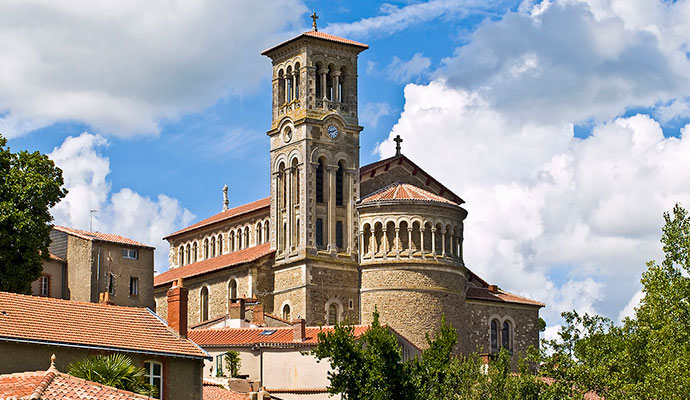
Clisson
Your first impression on arriving at this delightful town on the banks of the Sèvre Nantaise River, just 45 minutes southeast of Nantes and just across the northernmost border of the Vendée, is of having somehow strayed into a corner of Tuscany – an unexpected side-effect of the Vendée Wars.
The Republicans’ relentless ‘fire-and-sword’ policy ruined the castle in 1794 and flattened Clisson, leaving just two ancient bridges across the Sèvre and its tributary, the Moine. Rebuilding was started in Italian style by wealthy brothers Pierre and François Cacault, with Frédéric Lemot, a sculptor whom they had known in Italy.
The idea caught local imagination and from the early 19th century all kinds of Italianate buildings – including factories – grew up along the two rivers. Today, on summer nights when they are floodlit, Clisson’s ruined castle, steep cobbled streets and flights of steps take on a truly magical quality. Try to avoid visiting between Sunday and Tuesday, though, as either castle or shops are closed. Across the ancient packhorse bridge, the St-Antoine district on the north side of the river is taking on a new lease of life.
In recent years, a smart hotel has opened in the restored watermill, and around the town centre are a clutch of art galleries, smart shops and one of the upmarket La Fraiseraie ice-cream parlours. Just outside town, though easily walkable, is the gateway to the Garenne Lemot park. Back on the south side of the bridge, Friday mornings see Clisson’s busy street market. There are restaurants to suit every taste and pocket, and shady picnic places near the Moulin Plessard watersports base, about 500m southeast.
Clisson enjoys a full programme of festivities throughout the year but oenophiles might brighten up their winters on the first Sunday in December with a visit to the Nouvel An du Muscadet, where tasting the year’s new wines is the focus. Rather more left-field for this peaceful area is the Hellfest, a heavy-metal festival that rocks the place every June.
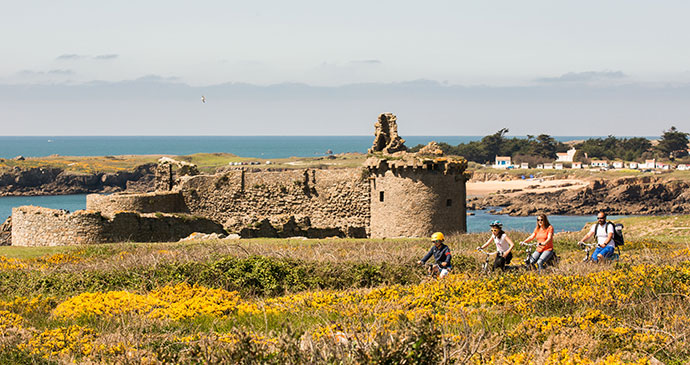
Île d’ Yeu
Time seems to have stood still on the picturesque island known as the Île d’ Yeu , 23km2 of pure bliss that lie less than an hour off the coast to the west of St-Gilles-Croix-de-Vie.
Few cars travel the gorse-lined lanes, and the island’s houses, often topped with pretty weather vanes and shuttered in gentle colours, seem bleached by the thousands of hours of sunshine that beat down on them.
Bicycle is king along the quays of the island’s capital, Port-Joinville, though challenged by Renault 4s and Citröen 2CVs, cars of yesteryear that dare to push gently through the hordes of bronzed, bicycled summer residents towing shopping trailers behind their two-wheeled transport. In Rue de la République, the narrow shopping street just one block back from the seafront, even bikes are frowned on, and pedestrians have it to themselves. In July and August, the market takes place daily.
The northeast side of the island is full of sheltered, sandy beaches for swimming and picnicking. On weekdays off-season, take your pick and you may have the sands to yourself.
More dramatic features will be found on the wild, rocky south coast: the 40m-high Grand Phare, or lighthouse, built in the 1950s; the caves on the Sables Rouis beach; the ruins of a feudal fortress (the Vieux Château); the pretty fishing harbour of Port de la Meule overlooked by the tiny, whitewashed chapel of Notre-Dame-de-Bonne-Nouvelle, to the east; a Toytown-sized harbour on the western edge of the sandy Plage des Vieilles; and, in the village of St-Sauveur at the centre of the island, an attractive Romanesque church – one of the oldest in the Vendée – founded in the 6th century by St Martin of Tours.
Among several Neolithic monuments is an enormous, rat-shaped stone, the pierre tremblante, balanced above a cliff to the east of Port de la Meule, which will move if pressed firmly in a particular spot.
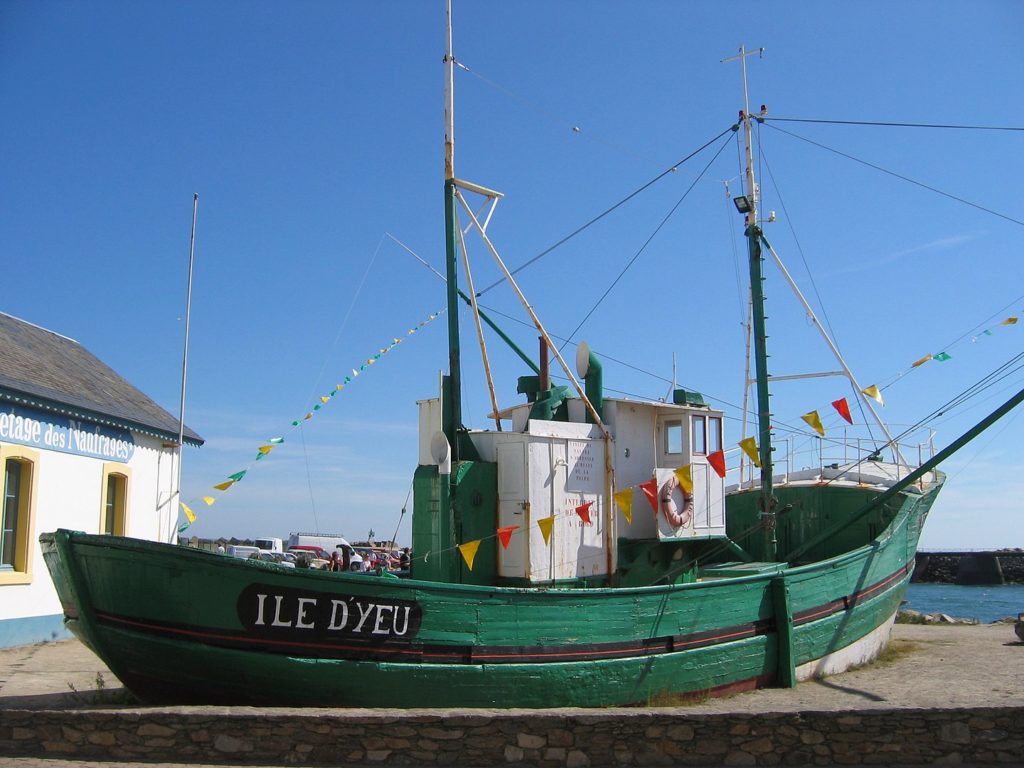
In 1945, the 90-year-old Marshal Pétain, who headed France’s pro-German Vichy government during World War II, was incarcerated in the gloomy Pierre-Levée fort after his death sentence for treason was commuted to life imprisonment. He died six years later, and is buried in the island’s cemetery.
Yes, there are points of interest here to fill your days, but the perfect experience on this island pearl is to grab a bike and pedal gently, your nostrils filling with floral scents, then pine, perhaps a hint of wood-smoke, then flowers yet again. If you can linger longer than a day, the island will grab hold of you, massaging you into a slower pace of life, one that is all too rare, all too necessary.
At Ascension, in even-numbered years, the island holds a flower festival, while in odd-numbered years there is a festival of the sea. If you’re looking for culinary specialities, try the tuna, the patagos/palourdes (clams) served with cream sauce, morgates (squid), tarte aux pruneaux (prune tart) or Min-Min (prune-and-butter sweets).
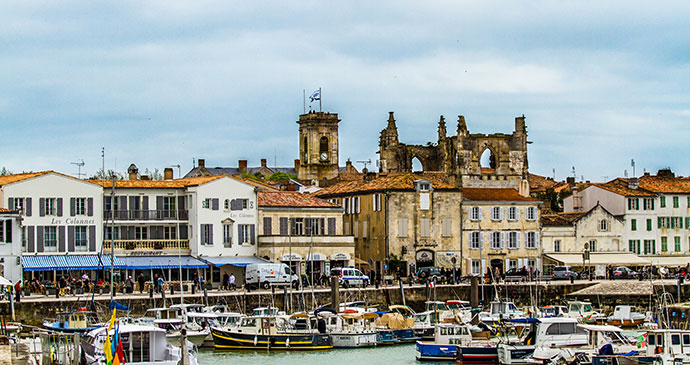
Île de Ré
Once four separate islands, Île de Ré is now just one – and a rather delightful one, too. Joined to the mainland by an impressive bridge that connects just northwest of La Rochelle, the island can hardly be called ‘undiscovered by visitors’, whether they come from the rest of France or further afield.
Undiscovered, no, but – to the outsider eye at least – largely unspoilt. True, the infrastructure is firmly in place here to greet the crowds that arrive year after year in the summer holidays. Campsites, hotels, holiday villages and chambres d’hôte are all here to host you, while there are plenty of delicious markets and good-quality restaurants to feed you.
More than half of the properties here are second homes, shuttered up for most of the year while their owners reside in Paris or elsewhere in mainland France. The result? House prices resemble telephone numbers! The good news for visitors is that this influx of outsiders has raised the level of cuisine on offer here, a notch up from what you might expect. Island prices are high though, so expect to pay more for your morning coffee.
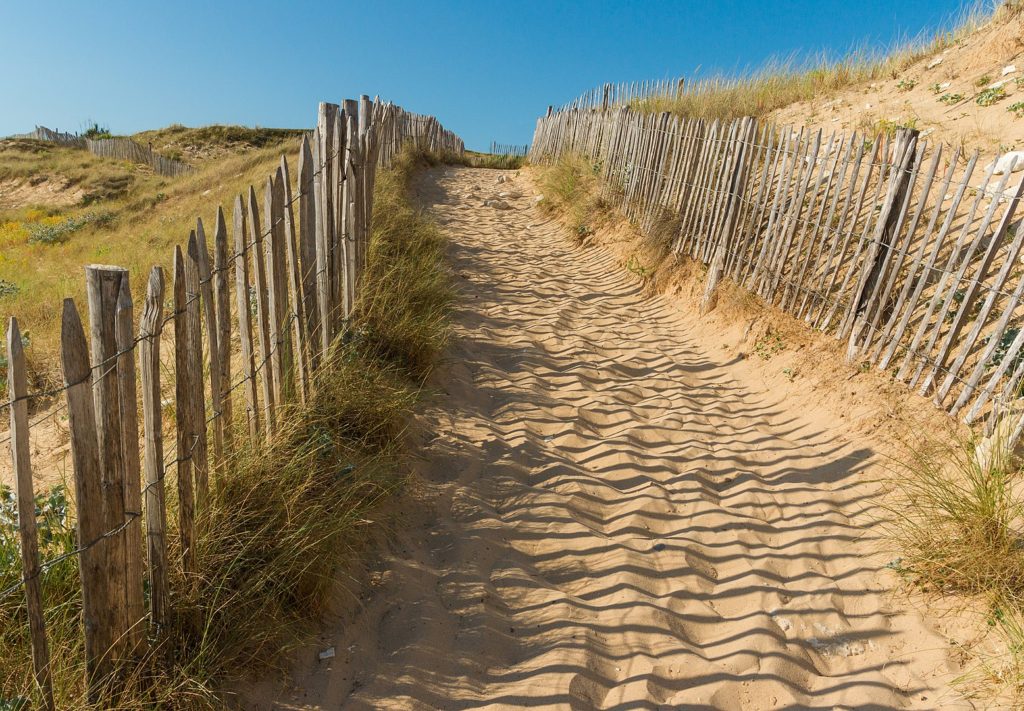
If you do decide to bring your car and then insist on using it to any degree, you will find yourself in the minority, for two wheels are better than four on Ré. Ample cycle paths lace this flat island and they are well used, even in off-season and on the odd days when it rains. Bikes can be hired in every village of note, with electric ones for those who need assistance.
The ten quaint island villages are impeccably kept, from low-level La Flotte to the more imposing but elegant three-storey ‘bourgeois’ edifices of St-Martin-de-Ré, the island capital. Some of the 30 beautiful beaches become visible from the bridge before you even arrive on the island, but the best ones decorate the southern shores a little further west.
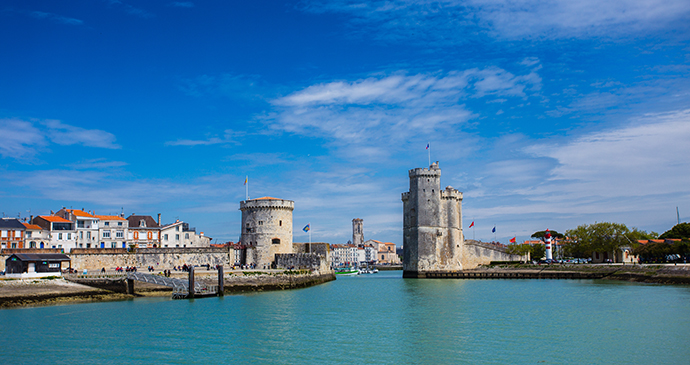
La Rochelle
Less than a half-hour’s drive south of the Vendée sits the capital of Charente-Maritime département, the lively seaport of La Rochelle. A modestly proportioned town of 80,000 inhabitants, this is a fascinating place with history oozing from its arcades, harbour and quaint streets, before you even get to its collection of diverse museums.
‘Belle et rebelle’ (‘Beautiful and rebellious’) is the Rochelais motto, apt for a city that is both elegant and steeped in a history of resistance. Fully deserving of its reputation as one of France’s best-known and most attractive ports, this historic city is within easy reach for anyone staying in the south Vendée. Indeed, its airport and railway station make La Rochelle highly accessible from Britain as a short-break destination in its own right and it’s also a renowned stopover for sailors.
Principal shopping streets are the Grande-Rue des Merciers, full of half-timbered buildings, and Rue du Palais, which has a branch of the Galeries Lafayette department store.
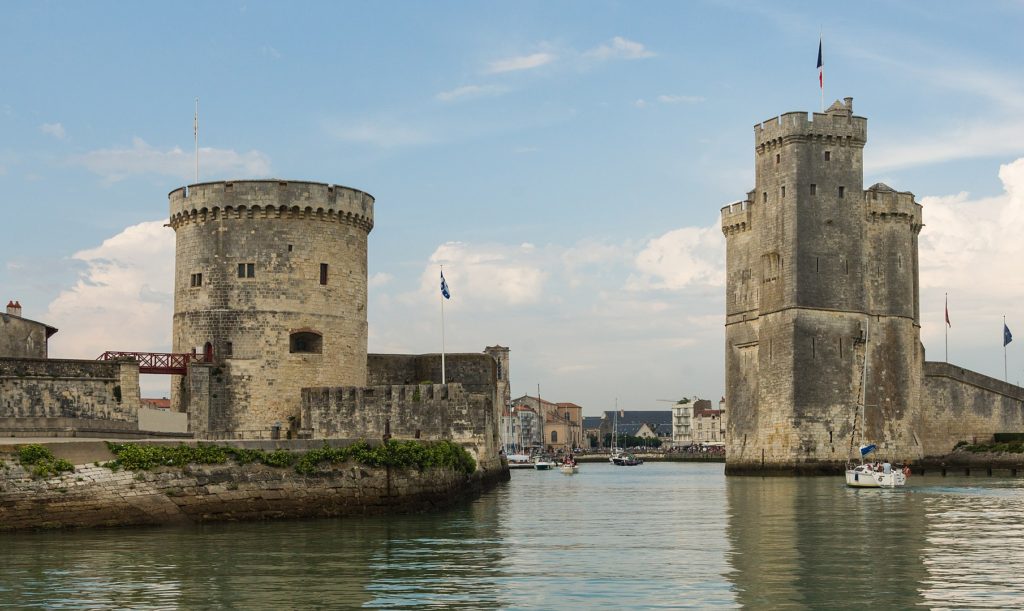
Particularly pleasing are the covered, arched and galleried pavements which hide the shopfronts for those who want to see unspoilt façades but which allow the retail fun to continue in bad weather. The market on Wednesday and even more so on Saturday is a must, with the surrounding streets closed to traffic.
In the roads around the fairy-tale-style hôtel de ville (town hall), look out for the 16th-century Maison Henri II, the mirrored gilt splendour of the Café de la Paix on Place de Verdun, and the Porte de la Grosse Horloge – the gateway between port and city. La Rochelle also offers a small, town-centre beach: tiny Plage de la Concurrence, just west of the Tour de la Lanterne.
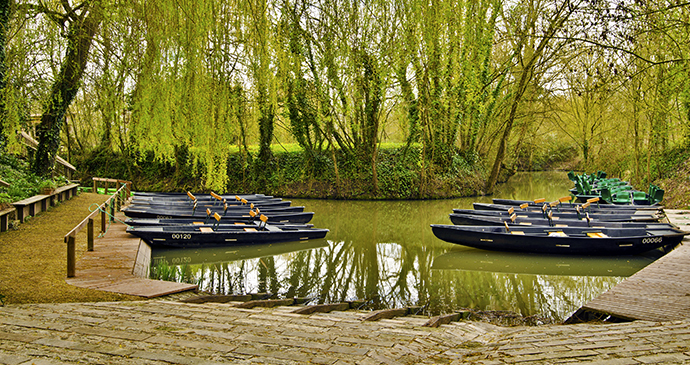
Marais Poitevin
A narrow coastal strip; a huge expanse of open fenland or ‘dry marshes;’ and a captivating area of ‘wet marshland’ bearing the name of La Venise Verte, or ‘Green Venice’: these three elements combine to form the Marais Poitevin, or Poitou Marshes, that occupy nearly all the terrain of the southern Vendée. It is the second-largest wetland in France (after the Camargue).
On the coastal strip, La Tranche-sur-Mer is renowned for its beaches, sunshine and watersports and has long revelled in its reputation as a popular holiday destination. Along with the neighbouring resorts of La Faute and L’Aiguillon-sur-Mer, it provides the ideal location for those seeking a relaxing time on the sands, and offers enough leisure attractions within easy striking distance, perfect for days when doing nothing proves to be just too much.
Inland, nearly 50,000ha of land reclaimed from the sea constitute the dry marshes, by far the biggest part of the Marais Poitevin Natural Park. If you’re looking for distractions from the flatness of this treeless landscape, just head northeast to the wine village of Mareuil, or visit Luçon – a dignified town with a cathedral that has for centuries been the seat of the bishops of the Vendée. Birdwatchers will revel in the numerous species on view at St-Denis-du-Payré.
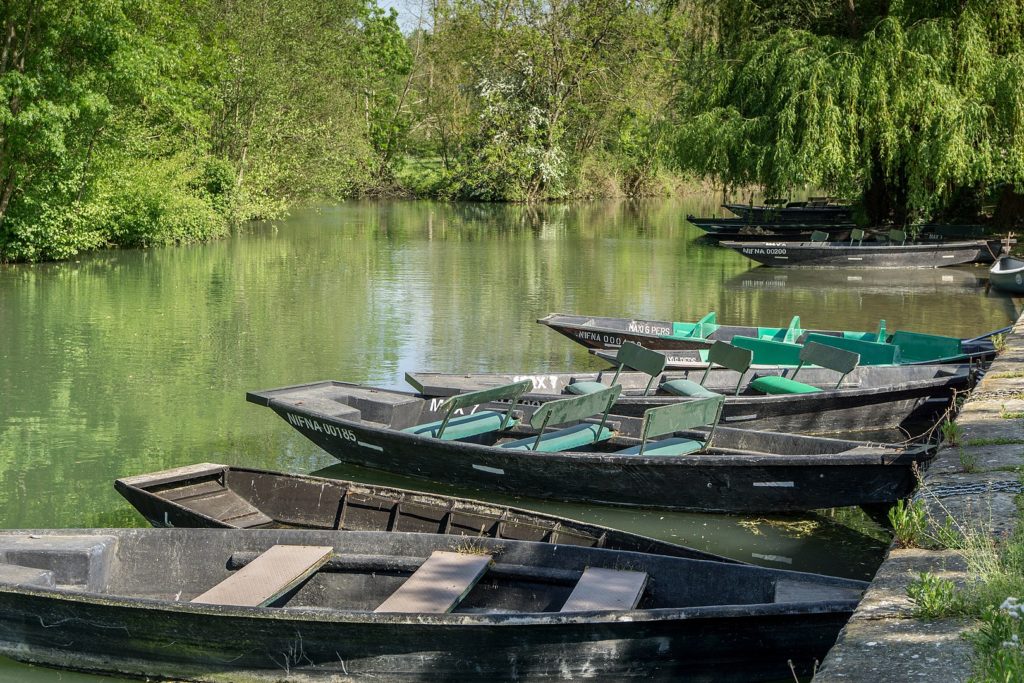
But while the coastline and the inland towns of the dry marshes certainly have their attractions, the flagship feature of this southern part of the Vendée is the area known as the Venise Verte, or ‘Green Venice’ which spills over the Vendean border and shares its delights with the two neighbouring départements of Charente-Maritime and Deux-Sèvres. No-one coming to this region should miss a trip to this, the most famous area of what is France’s second-largest humid zone.
This carefully preserved green and leafy part of the southern marshlands is full of picturesque villages, which together with numerous canals and cycleways play their part in luring around 1.5 million visitors to the Marais Poitevin every year. Here, you can travel by boat or bike among a maze of tranquil, tree shaded waterways – a wonderful antidote to the frenzy of everyday life.
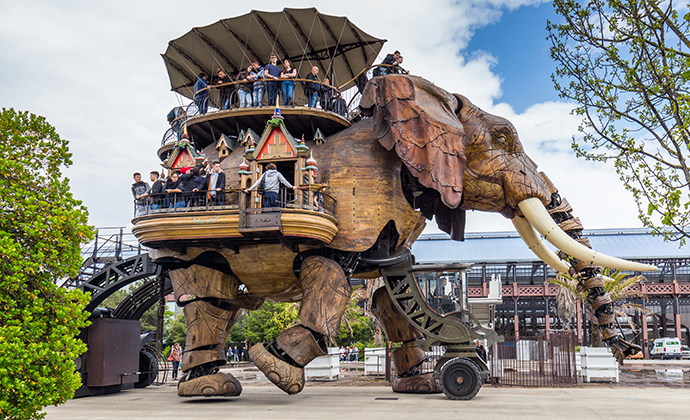
Nantes
Shipbuilding, biscuit manufacturing, sugar refining and food canning were the traditional livelihoods of this pleasant river port of just under 300,000 inhabitants, making it France’s sixth-largest city.
Include the larger metropolitan area and the population doubles. And it’s a population that’s steadily increasing: a former European Green Capital and straddling the Loire, Nantes is regularly voted by readers of influential French magazines as the town in which they would most like to live and certainly has enough to justify a couple of days’ stay.
For visitors, this is perhaps a city still lacking a bit of international high profile, but it’s certainly not through want of trying. Renovated museums, constantly changing art installations and a well-presented history added to a decent gastronomy and a swish transport network ensure that the city is always ready to welcome you.
Along the river to the west, you will easily spot la grue jaune, one of the two decommissioned giant Titan cranes that still keep alive a trace of the shipbuilding past of the city. Located opposite the Maillé-Brézé warship, now a visitor attraction in its own right, this brightly painted yellow crane near the west end of the Île de Nantes reminds us that thousands used to work here, commuting on the old transporter bridge, a model of which you can see in the Chantiers Navals museum.
Harnessing the city’s traditional metalworking heritage, an inventive company has installed workshops to produce Les Machines de l’Île – crazily inspired creations that are a cross between the dreams of Jules Verne and of William Heath Robinson. Ever ridden on a mechanical elephant? Or a giant spider? Now is your chance! As well as this ‘surrealistic bestiary’, other inhabitants of the creative quarter of the Île de Nantes include a maritime-themed carousel and a host of other thought-provoking artworks, including Les Anneaux de Buren, a series of 18 enlightened rings that frame the river landscape.
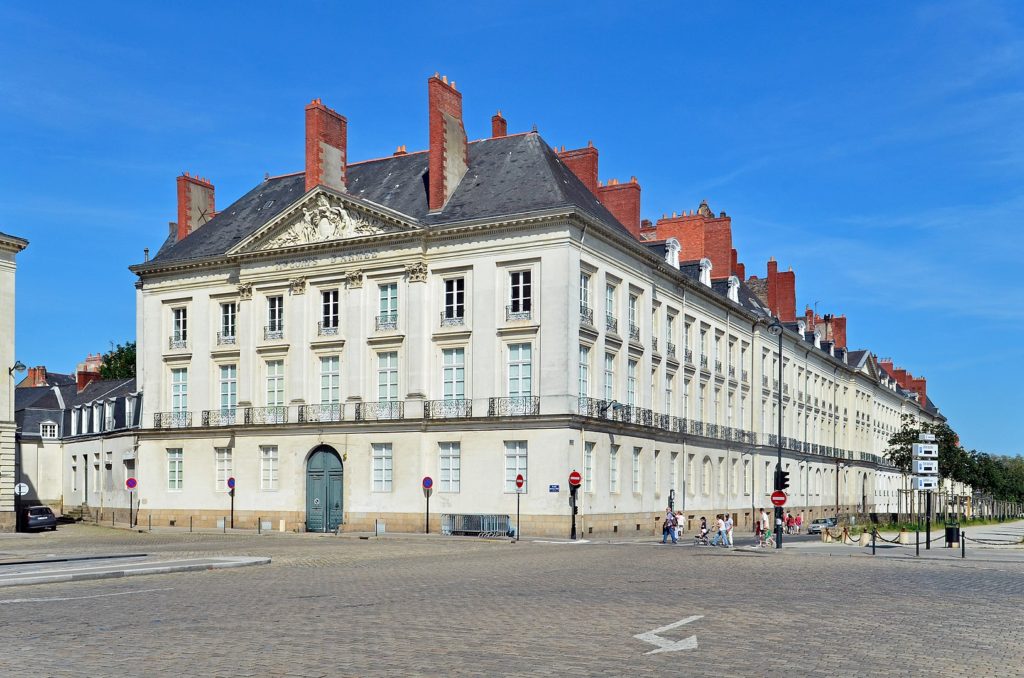
Nantes’ historical quarters have two distinct characters, divided by the Cours des 50 Otages – a central north–south boulevard. To the east is the old town, a series of narrow pedestrianised streets around the chateau and the Ste-Croix church containing 15th- and 16th-century houses and many small shops, plus a branch of the Galeries Lafayette department store (on Rue de la Marne).
To the west lies the busy Place du Commerce, a bustling interchange for tram and bus passengers. Off it, Rue de la Fosse has some chic shops en route to smart Place Royale. Also off Place du Commerce is the Passage Pommeraye, a unique 19th-century arcade on three different levels linked by decorated steps that rise steeply to finish at Rue Crébillon – the city’s smartest shopping street. (Whether you choose to shop there or not, walking the Passage Pommeraye is a must.)
Up here, turn left for Place Graslin, with its shiny-stoned opera house and glorious turn-of-the-century brasserie, La Cigale, which demands of you at least a coffee stop. Just south of Place Graslin lies an elegant, traffic-free avenue of 18thcentury houses called Cours Cambronne. In the historic centre, look out for street signs in both French and Breton, reminding you again that Nantes was once the capital of Brittany.
For fun, there’s the annual Voyage à Nantes and the Folle Journée, a themed classical-music festival which stretches across five days in early February. Jazz fans flock to town at the beginning of September for Les Rendezvous de l’Erdre.
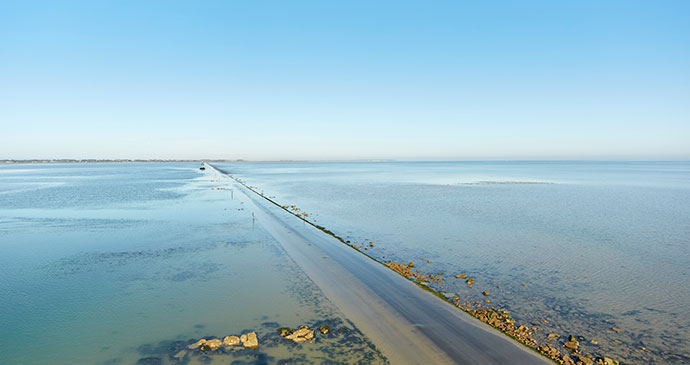
Passage du Gois
A drive either to, or from, Noirmoutier island along this part-cobblestone causeway edged with seaweed and glistening with sea water is a magical experience – particularly on a moonlit night. Until 1971 the 4.5km causeway, passable just twice a day either side of low water, was the only access to Noirmoutier, except for a passenger ferry from Pornic.
Its dog-leg route is studded with sturdy poles and platforms that provide windswept sanctuary for anyone caught out by the rising waters; if you return for a look at high tide you can see why they might be necessary!
Nature and tides are merciless, and the road has a history of being damaged and destroyed by storms. You should treat this phenomenon with the greatest respect. Tide tables (horaires des marées) are available from tourist offices in the area to indicate safe crossing times, which vary each day.
For the 3 hours that bridge the low tide, there is an extraordinary amount of activity, as the locals drive off onto the occasional hard area of seabed to take advantage of extra-low tides. They scrabble in the mud flats for cockles and clams, or search out oysters and other shellfish, accompanied by tractors to haul the catch to dry ground. At the island end of Le Gois, signboards give information about the birdlife and the 2011 construction of the causeway, which was visited by the 1993 and 2011 Tour de France cycling events.
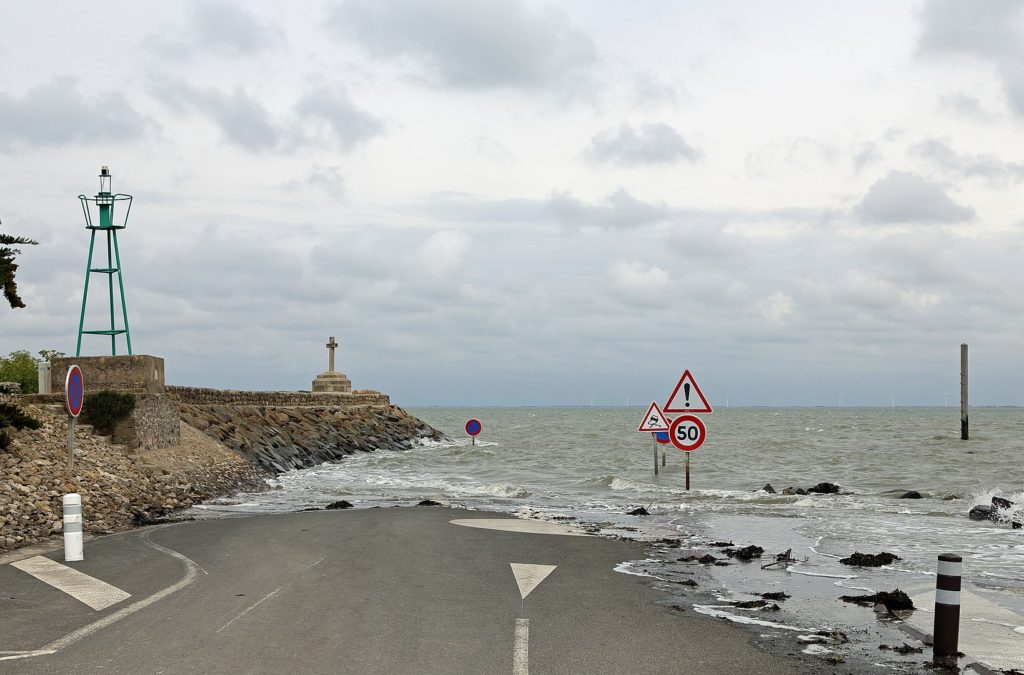
Allow plenty of time to cross at peak periods (summer Sunday afternoons, and throughout July and August); it can be a bit worrying to find yourself stuck in a traffic jam, beginning to fret about the rising tide.
The handsome bridge from near Fromentine now provides alternative – if less exciting – road access. For the return to the mainland, follow the signposts to Sortie de L’Île or even occasionally ‘continent’ – either par le pont (by the bridge) or par Le Gois (by the causeway).
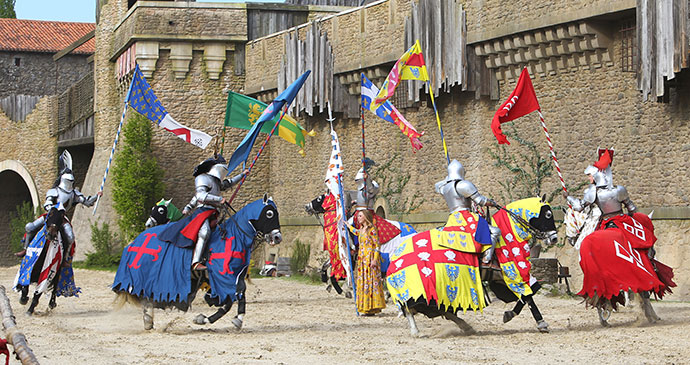
Puy du Fou
Astonishing special effects, dancing horses, castles that rotate, Viking longships that emerge from underwater, audiences that revolve, jousting knights, fantastic panoramic cinemas, spectacular dance sequences, fire and smoke, automated minstrels … surely there can be no better way to have a history lesson than to visit the Puy du Fou?
A whole day is not enough to take in the ever-increasing amount of entertainment on offer at this immaculately conceived, wonderfully crafted and impeccably organised multi-award-winning ‘historical theme park’ which celebrated its 40th anniversary in 2017. Every year, the park develops, constantly innovating to maintain its place as one of the world’s very best.
In between these spectaculars, rest assured that there will never be a dull moment. You will visit immaculate gardens; a reconstructed 18th-century Vendean village (including a spookily gloomy tunnel with re-creations of scenes from the Vendée Wars); a ‘medieval’ township full of costumed entertainers and wandering pigs and poultry; a fort and thatched village typical of the year 1000; fountains that ‘dance’ to Baroque music; and the secret world of the Templars, guided by a medieval knight.
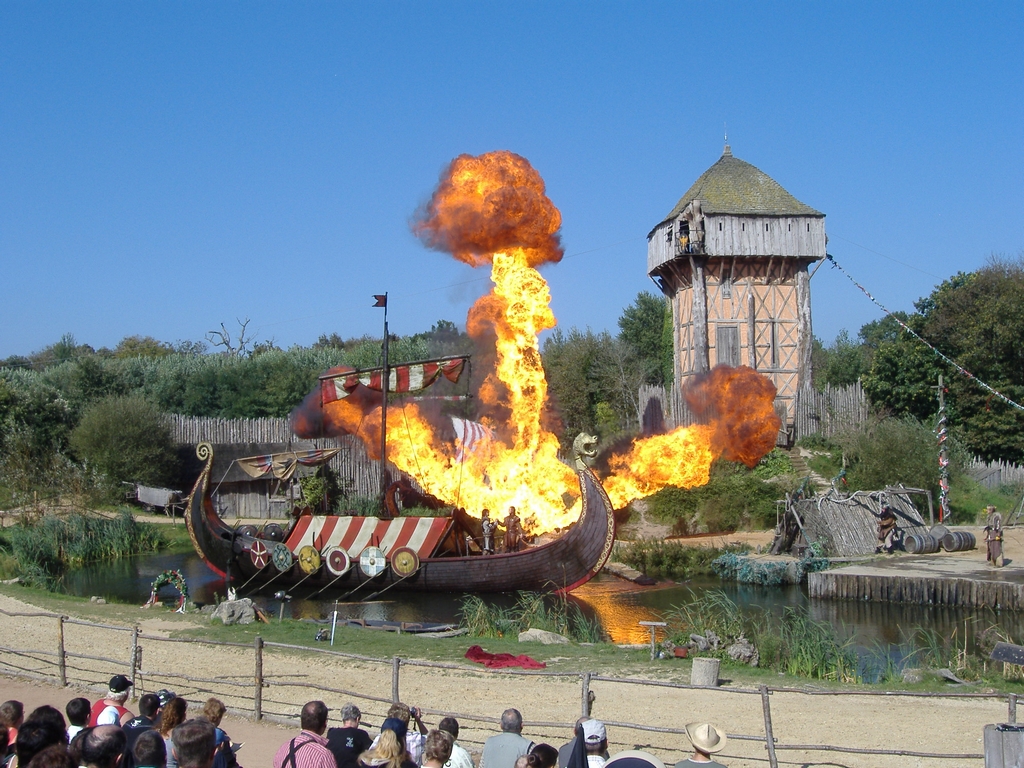
A large indoor theatre houses the ‘Mousequetaire de Richelieu’ show, its weak plotline compensated for by much 17th-century swashbuckling, fantastic equestrian displays on water, swordfights and a stomping dance finale that rightly belongs in Andalucia.
If the budget allows, you could book into the reasonably priced on-site hotels (there are five of them!) and take two days to enjoy the attractions.
More information about Puy du Fou
To learn more about this magical, borderline surreal family experience, visit the website at puydufou.com.
Related books
For more information, see our guide to the Vendée:
Related articles
This French region has all the ingredients for a classic family holiday.
Home to Europe’s best theme park, this region of France is ideal for a family holiday.
From Botswana to Brazil, we’ve picked our favourite wetlands from around the globe.
If you’re travelling to the Vendée and want to touch its identity, you need to unlock its dark history. A perfect way of doing so is by visiting these memorials to the bloody conflict.
Whether you want to sample unique cuisine, learn about local history or explore the great outdoors, the Vendée offers plenty for the visitor to enjoy. Here are seven reasons why the region should be on your travel list.
If you’re a foodie, you need to travel to the Vendée! Here are ten local specialities you shouldn’t miss out on.
